Interview by Hannah Carroll Harris // Mar. 11, 2020
Berlin-based artist Beatriz Morales was recently invited to the Museo MACAY to present her first ever solo institutional show in her home country of Mexico. For ‘Planos Disfrazados’—which translates to “disguised planes”—Morales has created a monumental immersive installation that re-interprets traditional Mexican craft techniques and materials through her signature bright, neo-abstract-expressionist style, marking a major transformation in her practice.
Consisting of two main components—KAAN (snake skin) and KIHAAB (agave fiber) in Mayan—the work combines traditional natural materials and large “skins” of acrylic paint, a shift in how the artist approaches colour and scale. A large tapestry of pastel-hued cactus fibre serves as a backdrop for the artificial neon sheets of paint creating a striking material juxtaposition. The installation is accompanied by a video, in which we see ‘KAAN/KIHAAB’ interacting with the local surroundings. Sweeping aerial views of expansive landscapes are intertwined with the unfurling of these mammoth colourful pieces, bringing together three influences of Mexican culture, landscape and craft traditions. We spoke to Morales about her move away from the canvas and the process of working across continents.
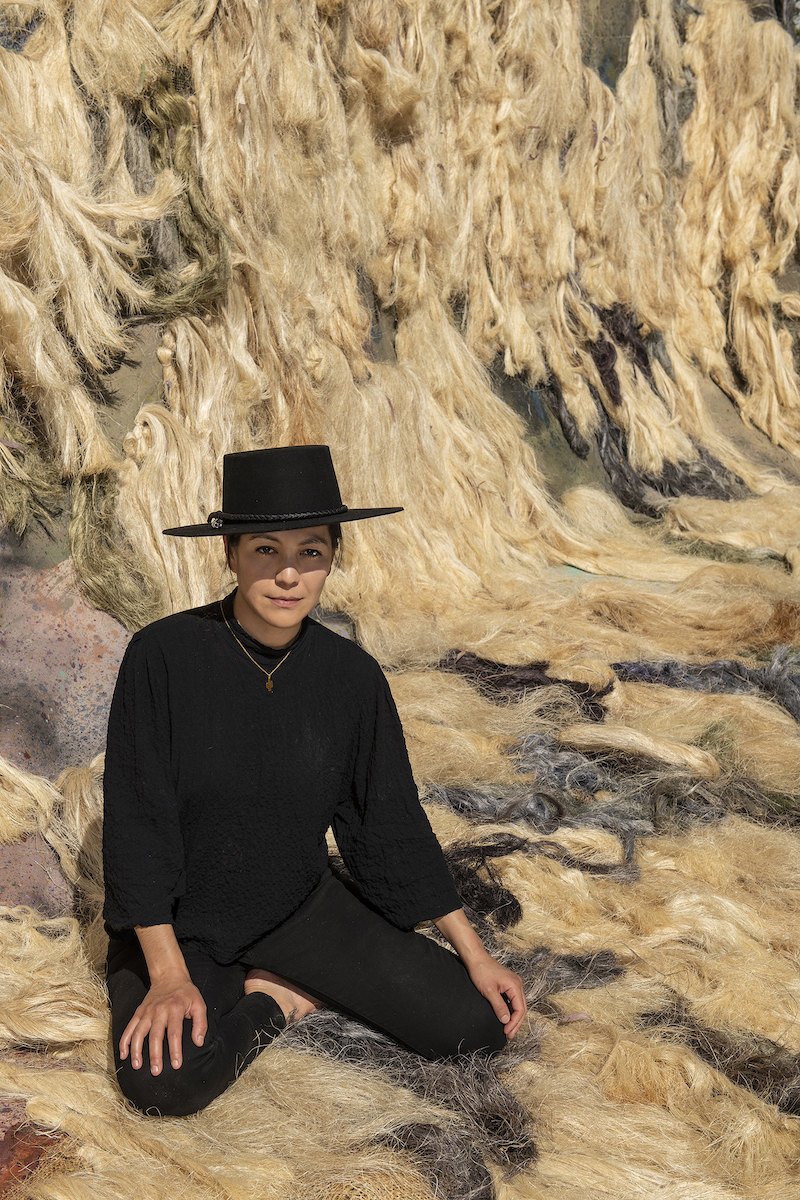
Beatriz Morales: ‘KAAN/KIHAAB’, 2020, exhibition view at Museo MACAY // Photo by Amanda Holmes
Hannah Carroll Harris: You have often described your practice as combining figurative and illustrative elements with an abstract expressionist approach. What drew you away from the figurative and towards large-scale installation for this exhibition?
Beatriz Morales: In a way, the work was shaped by the space and the country—Mexico—in which it was produced. When I was first approached by the Museo MACAY, I was immediately offered a huge space (the Expoforo) to work with, which is a massive colonial building in the heart of the historic center of Mérida. The whole building lives and breathes Mexican history, which in itself posed a particular challenge to me and gave me an inner direction. I knew from the outset that I wanted to work with the history, that site-specific energy and atmosphere, and I also knew that I would not be satisfied with merely filling the room with paintings. The physical size of some of my work has continually increased over the past few years, but the amount of space gave me the freedom to move way beyond the confines of the classic framed canvas. The exploration of identity, both on a personal as well as a universal and cultural level, quickly leads into abstract and emotional territory, so I never really considered a figurative approach here. That said, the abstraction in my work often carries hints to concrete inspiration. On one level, the large, frameless piece ‘KIHAAB’ can be read like a map of the arid landscape in Hidalgo, Mexico, where it was produced.
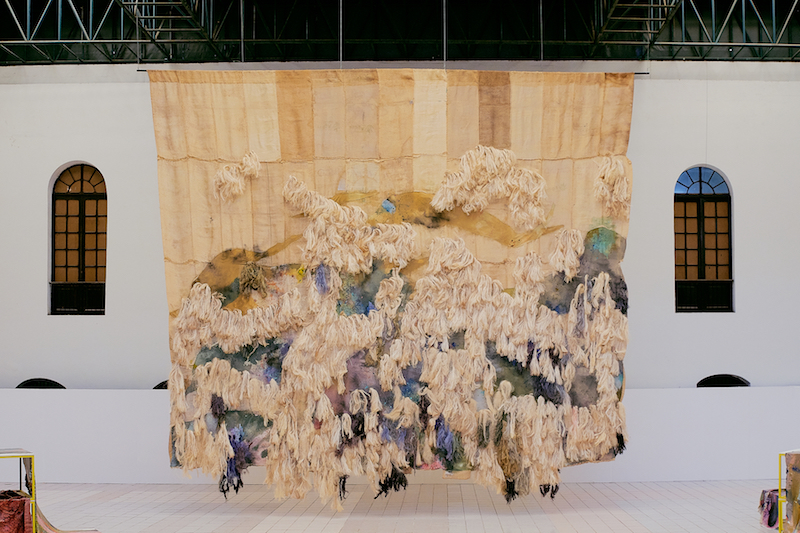
Beatriz Morales: ‘KAAN/KIHAAB’, 2020, exhibition view at Museo MACAY // Photo by Chiara Bonetti
HCH: In ‘KAAN/KIHAAB’ the body is referenced through the tactility of the materials and its scale in the space, rather than figuratively as in your previous work, and I’m interested in this shift of materials and process. What is the significance of the materials you have chosen?
BM: I have lived abroad for more than a decade, and during the planning of this show I realized that I had a strong desire to work with local Mexican materials, to reconnect with the environment of my home country. I decided to use materials that are typical to the Yucatan peninsula of Mexico. The Mexican economy is very agricultural, very rural and has strong local traditions of craft reflecting the wide range of landscapes and ecologies in this vast country. The “fur” or “wool” that covers ‘KIHAAB’ is all cactus fibre. The canvas itself is made out of repurposed jute bags, which were used to ship coffee, corn and cocoa beans, which are made of cactus. So this whole big piece is essentially made of cactus, treated with various dyes and colours. ‘KAAN’—the “serpent”—consists of 10 acrylic skins, each measuring 6 x 1 meters, in which I take the liberty of painting further by foregoing not only the frame but also the canvas itself. In the installation, these skins of colour, draped over metal surfaces, represent adaptability and they also allude to the jungle, the Mayan culture of Yucatan and the allegorical shedding of snake skin as a metaphor for changes in identity.
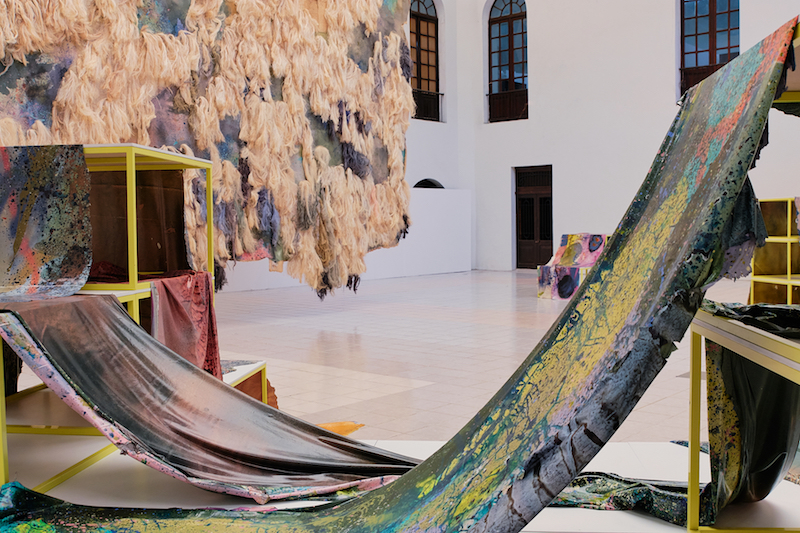
Beatriz Morales: ‘KAAN/KIHAAB’, 2020, exhibition view at Museo MACAY // Photo by Chiara Bonetti
HCH: This same approach to tactility is mirrored in the video component of the exhibition. Here, once again, we see the way in which your work has a direct reference not only to the body, but also to the land. The different painted or woven surfaces act as a skin connecting with the natural landscape in a really captivating way. Why was it important for you to show the work interacting with the land?
BM: Working with the atmosphere of the land, I wanted to show ‘KAAN’ and ‘KIHAAB’ in their natural environments, embedded in the landscapes that inspired and nurtured their creation, and the people of the land, the Mexican people I live with when working in my studio, are part of that environment. ‘KIHAAB’ reflects the tonality of the landscape of the state of Hidalgo around the time that corn is harvested in late autumn: the fields and the entire landscape turn from green to various shades of gold and brown. Looking at ‘KIHAAB’ in the video, you see how seamlessly it blends into the surrounding landscape. At times it is difficult to say where the piece ends and nature begins. This is exactly what I am interested in, and what I hope to achieve: to see my work as part of an environment, and to see it relate to that environment it belongs to. In that sense, it was important to me to show the video, which I produced together with Benjamin Zombori, to break out of the neutrality of the museum space.
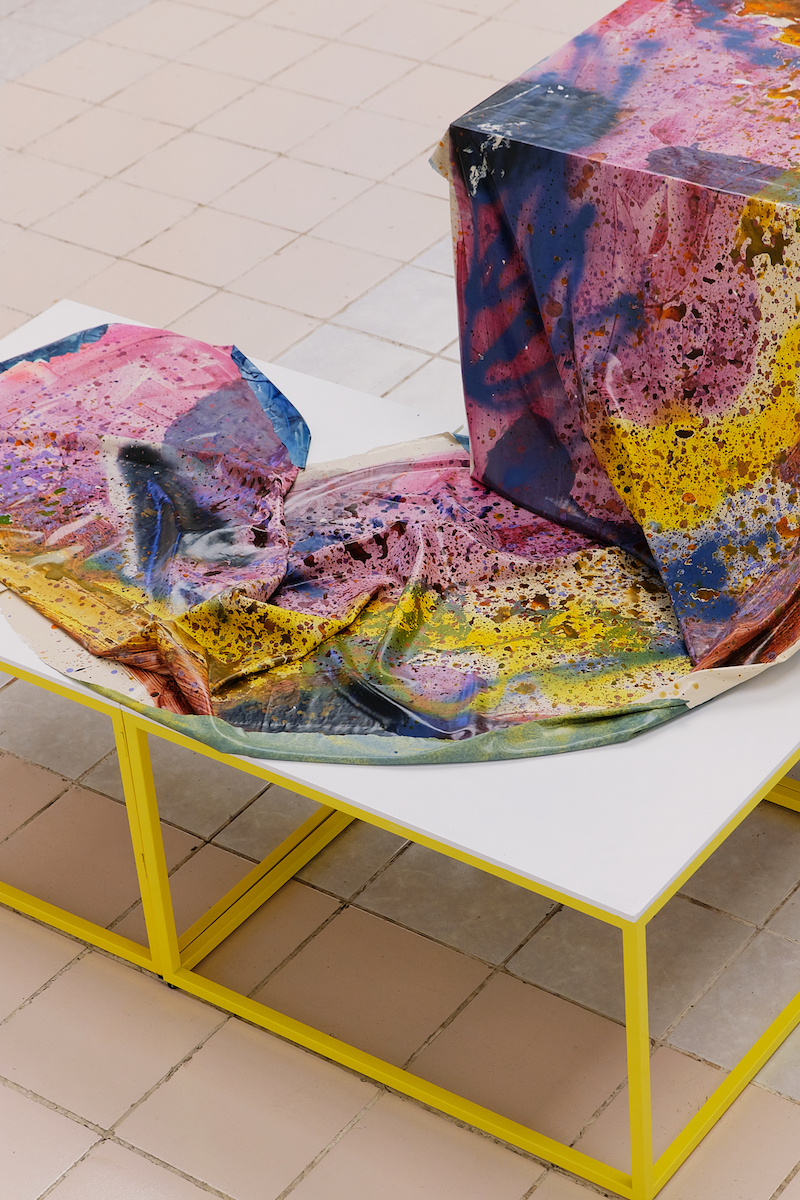
Beatriz Morales: ‘KAAN/KIHAAB’, 2020, exhibition view at Museo MACAY // Photo by Chiara Bonetti
HCH: Ideas surrounding concealment and the hidden have reappeared throughout your practice, whether in painting, sculpture or this new installation. Why is this a central theme for you and why do you choose to portray these ideas through such a vibrant exploration of colour?
BM: The way I understand life, not everything that is obvious or visible is automatically relevant. Quite the contrary. I find that often the story behind an object, a situation, a piece of art is what really sparks my interest and, usually, it is those stories and little bits of deeper context that I consider more substantial and real than the reflections of the surface that hit the eye first. In all my work I try to express those hidden depths. It is simply what interests me most in life. I cannot really say why colour is so important to me. It is like asking me why I walk the way I walk. I cannot explain it, my body, mind and being just aligns in a certain way. Expression through colour is my nature.
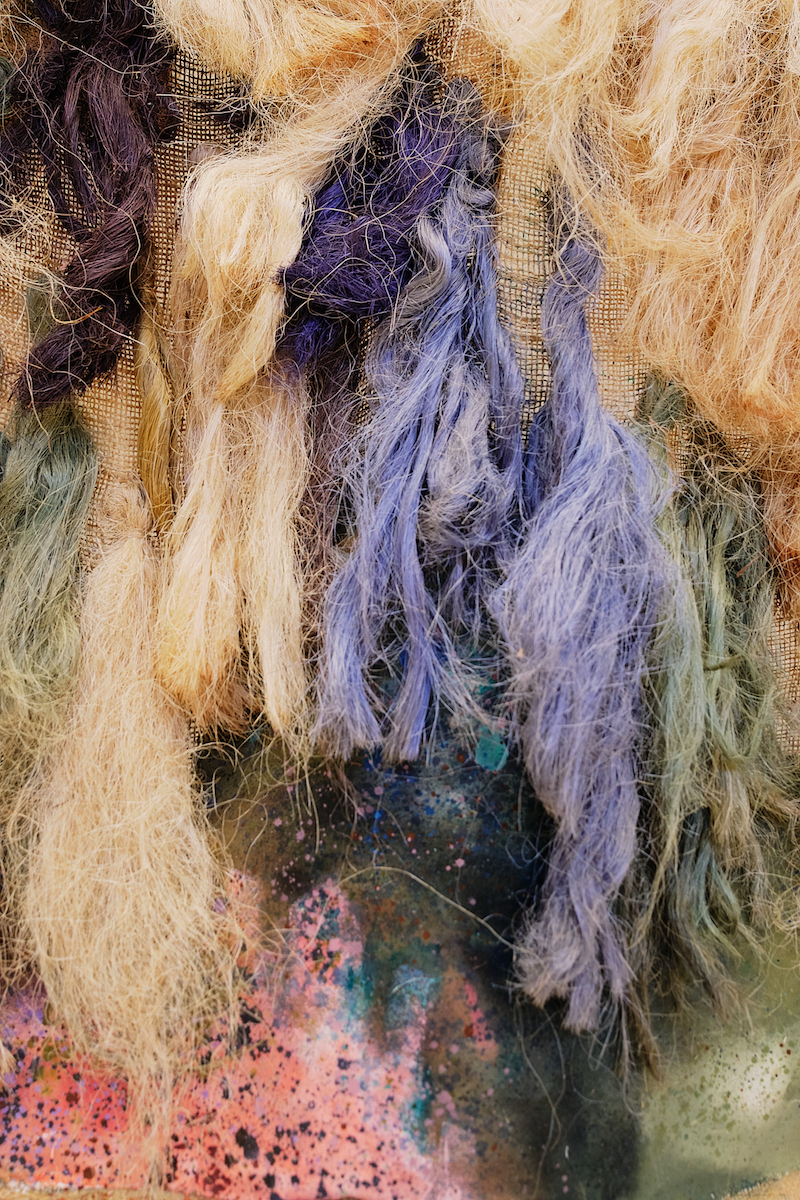
Beatriz Morales: ‘KAAN/KIHAAB’, 2020, exhibition view at Museo MACAY // Photo by Chiara Bonetti
HCH: Although your work may not seem overtly political, people often take political interpretations from it and foreground your work through the lens of your heritage. As someone who has exhibited widely both in Europe and Mexico, do you notice a difference in your approach to making depending on where it will be exhibited? And does it change the way the work is received?
BM: The exhibition at the MACAY is the first show I produced specially for a specific location and the fact that the museum happens to be in Mexico made me engage with questions I have about my own identity in a deep way. In Mexico, I am perceived as a painter who is firmly rooted in Berlin, whereas in Germany and Europe I am sometimes seen as an almost archetypal Mexican artist. Very broadly speaking, in my experience, Europeans see art through a much more political lens than Mexicans tend to.
In my understanding, the exploration of identity is always close to being a political act, whether intended or unintended. Exploring and challenging your own boundaries means you are automatically challenging the boundaries imposed on you by society, the political system you live in and the entire context you move through. So, I am not sure apolitical art really exists in that sense, wherever you work or exhibit.
Exhibition Info
MUSEO MACAY
Beatriz Morales: ‘Planos Disfrazados’
Exhibition: Jan. 24 – Mar. 31, 2020
Calle 60 502 B Altos, Centro, 97000 Mérida, Yuc., Mexico, click here for map
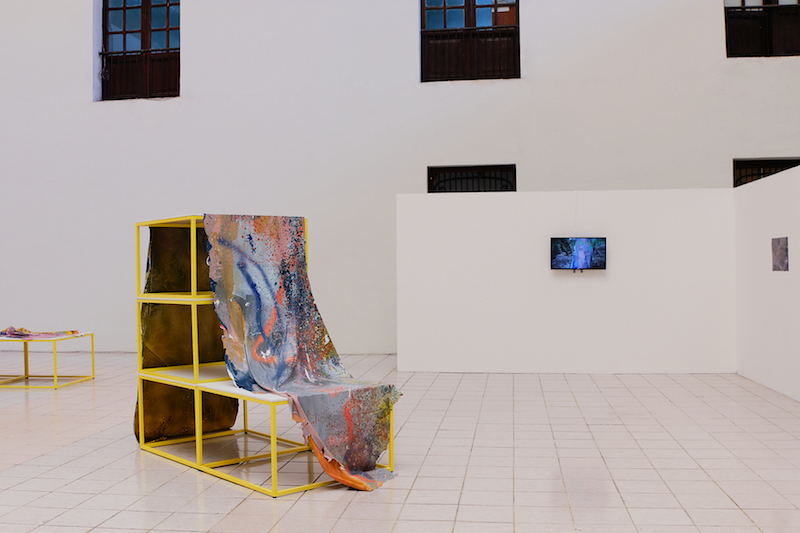
Beatriz Morales: ‘KAAN/KIHAAB’, 2020, exhibition view at Museo MACAY // Photo by Chiara Bonetti
























